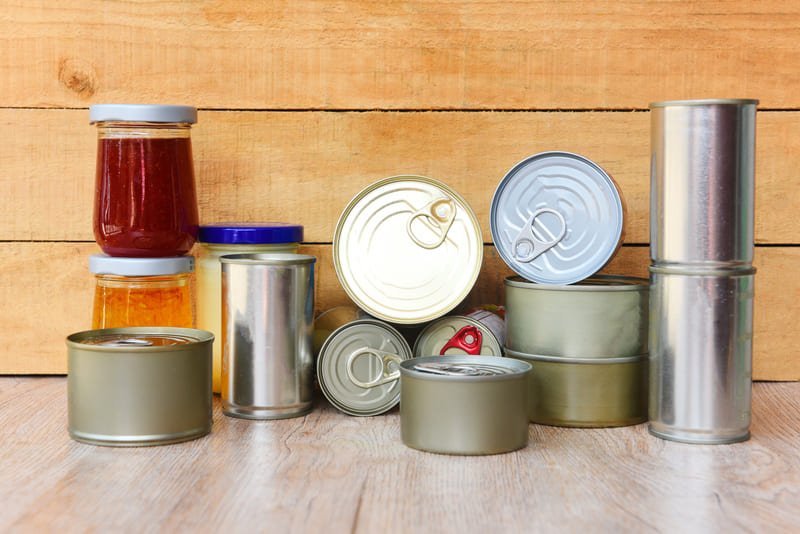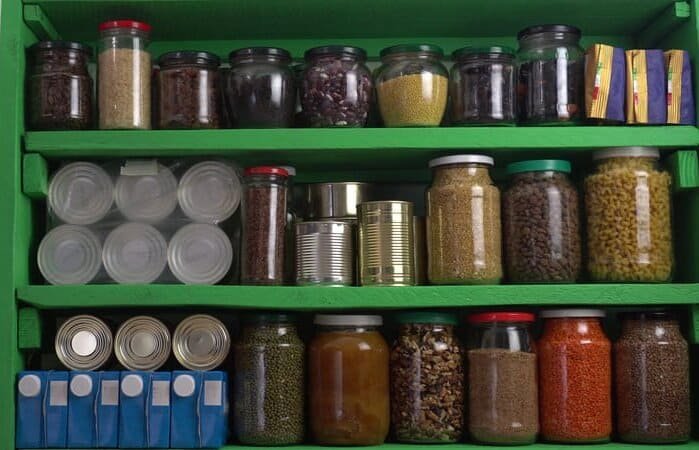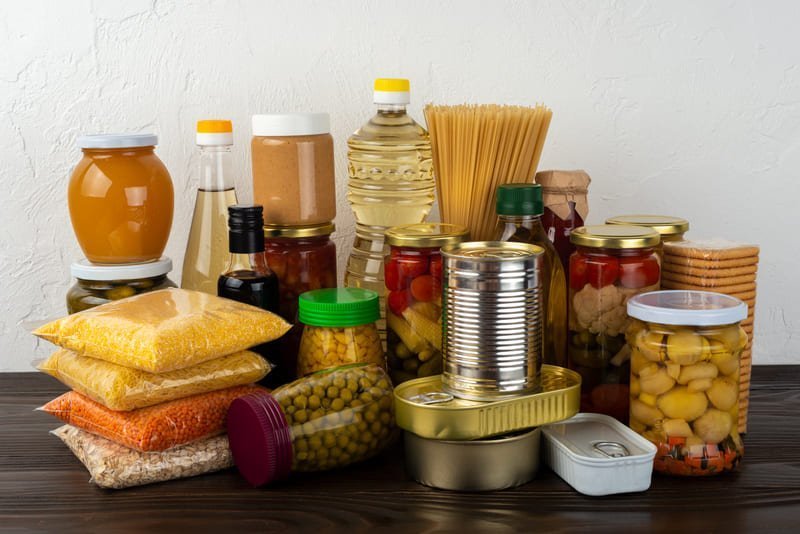Being prepared for emergencies and natural disasters is crucial, and food storage plays a vital role in ensuring your readiness. Whether you are a beginner or an experienced food prepper, these essential tips will help you stay ready for any situation.
Key Takeaways:
- Food storage is an important part of emergency preparedness for every food prepper.
- Short-term supplies should include ready-to-eat canned meats, fruits, vegetables, high-energy foods, and foods for special diets.
- For longer-term needs, build a two-week supply of well-balanced meals, including bulk staples and supermarket goods.
- Consider factors such as shelf life, easy storage, easy preparation, nutritional value, calorie density, and dietary restrictions when choosing emergency foods.
- Create a disaster supply kit that includes medical supplies, hygiene supplies, portable radio, flashlights, camping cookstove, money, and other essentials.
By following these tips, you will be better prepared to handle any emergency or disaster that comes your way. Stay ready and ensure the well-being of yourself and your loved ones with proper food prepping and storage.
Essential Criteria for Choosing Emergency Foods
When it comes to selecting foods for emergency situations, there are several important criteria to consider. These criteria ensure that the food you choose is suitable for long-term storage, easy to prepare, and meets your nutritional and dietary needs. Let’s take a closer look at each of these essential criteria:
Shelf Life
Emergency foods should have a long shelf life, lasting at least a year. This ensures that the food remains safe and nutritious during an extended crisis. Opt for foods that are specifically labeled for long-term storage.
Storage Convenience
Choose foods that are easy to store and handle during emergencies. Durable packaging, such as cans or boxes, is ideal for withstanding harsh conditions. These containers also help protect the food from pests and maintain its quality for an extended period.
Easy Preparation
During emergencies, access to utilities and cooking facilities may be limited. Therefore, it is crucial to select foods that require minimal preparation. Look for ready-to-eat options or foods that can be easily rehydrated or heated using alternative cooking methods, such as portable camping cookstoves.
Nutritional Value
Ensure that the emergency foods you choose provide essential nutrients to maintain strength and health during a crisis. Look for foods that offer a well-rounded nutritional profile, including carbohydrates, proteins, healthy fats, vitamins, and minerals. Consider including items like canned meats, dried fruits, and ready-to-eat cereals in your emergency food supply.
Calorie Density
Space is often limited when building a pantry for emergency purposes. Select foods that have a high calorie density, providing sufficient energy in a smaller volume. This allows you to maximize the number of calories you can store in limited space.
Dietary Restrictions
Consider any dietary restrictions or allergies that may be present within your household. Avoid foods that may trigger allergic reactions or conflict with personal dietary needs. Opt for foods that cater to specific dietary restrictions, such as gluten-free, vegetarian, or nut-free options.
“During emergencies, it’s crucial to choose foods that are easy to store, require minimal preparation, and meet your nutritional needs.”
By keeping these essential criteria in mind, you can confidently select emergency foods that are not only easy to store and prepare but also provide the necessary nutrition during challenging times.
| Criteria | Description |
|---|---|
| Shelf Life | Choose foods with a long shelf life of at least a year. |
| Storage Convenience | Select foods in durable packaging like cans or boxes. |
| Easy Preparation | Opt for foods that require minimal preparation. |
| Nutritional Value | Ensure the foods provide essential nutrients. |
| Calorie Density | Choose foods with high calorie density for limited space. |
| Dietary Restrictions | Consider personal dietary needs and preferences. |
Building a Disaster Supply Kit

As a food prepper, it is essential to have a well-stocked disaster supply kit. This kit should include a variety of items to ensure you are prepared for any emergency situation. Here are the key items to include:
Medical Supplies
Having a stocked first aid kit is crucial in any disaster situation. It should include bandages, antiseptic ointments, pain relievers, and any necessary prescription medications.
Hygiene Supplies
Maintaining proper hygiene is important, especially during emergencies. Pack items like hand sanitizer, soap, toilet paper, and personal hygiene products to keep yourself and your family clean and healthy.
Portable Radio and Flashlights
In a power outage or emergency situation, having a portable radio and flashlights becomes vital. These items will keep you informed and provide much-needed light during dark times.
Camping Cookstove and Fuel
If you’re unable to use your regular cooking appliances, a camping cookstove can be a lifesaver. Make sure to also pack enough fuel to sustain your cooking needs.
Money
Having cash on hand is crucial during emergencies, as ATMs and card readers may not be operational. Keep a small amount of cash in your disaster supply kit for essential purchases.
Infant Needs
If you have an infant, it’s important to include items like formula, baby food, diapers, and wipes in your supply kit. Make sure to regularly check and update these items to accommodate your baby’s growing needs.
Can Opener, Utensils, and Cookware
When packing emergency food supplies, don’t forget to include a can opener for canned goods. Additionally, pack utensils and cookware that you can easily use for cooking and eating.
Remember, it is crucial to periodically check and update your disaster supply kit. Ensure that all items are in working condition and replace any expired items. Being prepared with a well-equipped disaster supply kit will give you peace of mind knowing that you can handle any emergency with ease.
| Item | Quantity |
|---|---|
| Bandages | 1 box |
| Antiseptic ointments | 2 tubes |
| Pain relievers | 1 bottle |
| Hand sanitizer | 2 bottles |
| Soap | 2 bars |
| Toilet paper | 6 rolls |
| Flashlights | 2 |
| Portable radio | 1 |
| Camping cookstove | 1 |
| Cookware | 1 set |
| Utensils | 1 set |
| Money (cash) | $100 |
| Formula | 3 cans |
| Baby food | 12 jars |
| Diapers | 50 |
| Wipes | 2 packs |
Long-Term Food Storage Tips

In addition to short-term emergency supplies, building up a long-term food storage supply is essential for every food prepper. By stocking up on bulk staples and a variety of canned and dry goods, you can ensure that you have enough food to sustain you during extended periods of emergency or crisis. Here are some tips for long-term food storage:
| Food Items | Storage Recommendations |
|---|---|
| Bulk Staples (wheat, corn, beans, salt) | Store in airtight containers in a cool, dry place away from sunlight. |
| Canned Meats | Check for expiration dates and store in a cool, dry place. |
| Dry and Canned Beans | Store in airtight containers in a cool, dry place. |
| Rice and Pasta | Keep in airtight containers in a cool, dark place to prevent moisture and insect infestation. |
| Ready-to-Eat Cereals | Store in their original packaging, ensuring it is tightly sealed. |
| Dried Fruits | Store in airtight containers in a cool, dry place. |
Remember, proper storage conditions are crucial for maintaining the quality and shelf life of your long-term food supplies. Keep your dry ingredients or supplies off the floor in clean, dry, dark places away from sources of moisture. Regularly check and rotate your stock to ensure that you are using the oldest items first and replacing them with fresh ones.
By following these long-term food storage tips, you can be well-prepared for any emergency situation and have peace of mind knowing that you have a reliable food supply to sustain you and your family.
Takeaway:
Building a long-term food storage supply is crucial for food preppers. By purchasing bulk staples, canned meats, dry and canned beans, rice, pasta, ready-to-eat cereals, and dried fruits, you can ensure a diverse and reliable food supply. Proper storage conditions are essential for maintaining the quality and shelf life of your food. Regularly check and rotate your stock to keep it fresh and up-to-date.
Conclusion
Being prepared with an emergency food supply is essential for every food prepper. By following these essential tips, including prepping food for short-term emergencies and building a long-term food storage, you can ensure that you and your family are ready for any emergency or disaster.
Proper storage, rotation, and consideration for dietary needs are key factors in maintaining a well-stocked pantry. Make sure to store your food supplies in clean, dry, and dark places away from sources of moisture. Regularly check and update your supply to ensure that all items are in good condition and within their expiration dates.
Remember, meal prep is not just about convenience but also about emergency preparedness. By having a robust food supply, you can have peace of mind knowing that you are equipped to handle any unexpected situations that may arise. Stay prepared and stay ready with these essential food prepping tips.
FAQ
What should I include in my short-term emergency food supply?
It is recommended to include ready-to-eat canned meats, fruits, and vegetables, canned juices, milk, soup, high-energy foods, and foods for infants or those with special diets.
How long should emergency foods last?
Emergency foods should have a long shelf life, preferably lasting at least a year.
What factors should I consider when choosing emergency foods?
When selecting emergency foods, consider their storage ease, preparation convenience, nutritional value, calorie density, and any dietary restrictions.
What should be included in a disaster supply kit?
A disaster supply kit should include medical supplies, hygiene supplies, a portable radio, flashlights, camping cookstove and fuel, money, and items for infants if applicable. Other important items to include are a can opener, utensils, and cookware.
What should be in my long-term food storage supply?
You can include bulk staples such as wheat, corn, beans, and salt, as well as canned meats, dry and canned beans, rice, pasta, ready-to-eat cereals, and dried fruits for added variety.
How should I store my long-term food supplies?
Store all dry ingredients or supplies off the floor in clean, dry, dark places away from sources of moisture to maintain the quality of the food for a longer period of time.












